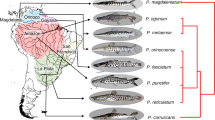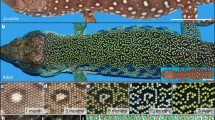Abstract
We study a three-variable Turing system with two kinds of cells and a diffusive chemical, considering the formation and maintenance of fish skin patterns with multiple pigment cells. The two types of cells are produced from undifferentiated cells. They inhibit the supply rate of the other cell type, forming local clusters of the same cell type. In addition, the cells of one type can be maintained only in the presence of a diffusive chemical produced by the other cell type, resulting in the coexistence of two cell types in heterogeneous spatial patterns. We assume linear interaction among cells and the chemical, and cell supply rates constrained to be positive or zero. We derive the condition for diffusion-driven instability. In one-dimensional model, we examine how the wavelength of the periodic pattern depends on parameters. In the two-dimensional model, we study the condition for spot, stripe or reversed spot pattern to emerge (pattern selection). We discuss heuristic criteria for the pattern selection.
Similar content being viewed by others
References
Arcuri, P., Murray, J.D., 1986. Pattern sensitivity to boundary and initial conditions in reaction-diffusion models. J. Math. Biol. 24, 141–165.
Asai, R., Taguchi, E., Kume, Y., Saito, M., Kondo, S., 1999. Zebrafish Leopard gene as a component of the putative reaction–diffusion system. Mech. Dev. 89, 87–92.
Barrio, R.A., Varea, C., Aragon, J.L., Maini, P.K., 1999. A two-dimensional numerical study of spatial pattern formation in interacting Turing systems. Bull. Math. Biol. 61, 483–505.
Cartwright, J.H.E., 2002. Labyrinthine Turing pattern formation in the cerebral cortex. J. Theor. Biol. 217, 97–103.
Crampin, E.J., Gaffney, E.A., Maini, P.K., 1999. Reaction and diffusion on growing domains: scenarios for robust pattern formation. Bull. Math. Biol. 61, 1093–1120.
Dufiet, V., Boissonade, J., 1992. Numerical studies of Turing patterns selection in a two-dimensional system. Physica A 188, 158–171.
Ermentrout, B., 1991. Stripes or spots? Nonlinear effects in bifurcation of reaction–diffusion equations on the square. Proc. Roy. Soc. Lond. A 434, 413–417.
Gierer, A., Meinhardt, H., 1972. A theory of biological pattern formation. Kybernetik 12, 30–39.
Hirata, M., Nakamura, K., Kanemaru, T., Shibata, Y., Kondo, S., 2003. Pigment cell organization in the hypodermis of zebrafish. Dev. Dyn. 227, 497–503.
Hirata, M., Nakamura, K., Kondo, S., 2005. Pigment cell distributions in different tissues of the zebrafish, with special reference to the striped pigment pattern. Dev. Dyn. 234, 293–300.
Hoshen, J., Kopelman, R., 1976. Percolation and cluster distribution. I. Cluster multiple labeling technique and critical concentration algorithm. Phys. Rev. B 14, 3438–3445.
Jung, H.S., Francis-West, P.H., Widelitz, R.B., Jiang, T.X., Ting-Berreth, S., Tickle, C., Wolpert, L., Chuong, C.M., 1998. Local inhibitory action of BMPs and their relationships with activators in feather formation: implications for periodic patterning. Dev. Biol. 196, 11–23.
Koch, A.J., Meinhardt, H., 1994. Biological pattern formation: from basic mechanisms to complex structures. Rev. Mod. Phys. 66, 1481–1510.
Kondo, S., 2003. Chemical reaction generating biological patterns. In: Sekimura, T., Noji, S., Morita, R. (Eds.), Diversity in Pattern and Form of Biological System, pp. 67–74. Shokabo, Tokyo (in Japanese).
Kondo, S., Asai, R., 1995. A reaction–diffusion wave on the marine angelfish Pomacanthus. Nature 376, 765–768.
Leppänen, T., Karttunen, M., Barrio, R.A., Kaski, K., 2004. Morphological transitions and bistability in Turing systems. Phys. Rev. E 70, 066202.
Lyons, M.J., Harrison, L.G., 1992. Stripe selection: an intrinsic property of some pattern-forming models with nonlinear dynamics. Dev. Dyn. 195, 201–215.
Maderspacher, F., Nüsslein-Volhard, C., 2003. Formation of the adult pigment pattern in zebrafish requires leopard and obelix dependent cell interactions. Development 130, 3447–3457.
Meinhardt, H., 1982. Models of Biological Pattern Formation. Academic, London.
Meinhardt, H., 1983. Digits, segments, somites—the superposition of sequential and periodic structures. In: Jäger, W., Murray, J.D. (Eds.), Lecture Notes in Biomathematics, vol. 55, pp. 228–245. Springer, Berlin.
Meinhardt, H., 1995. The Algorithmic Beauty of Sea Shells. Springer, Berlin.
Miura, T., Maini, P.K., 2004. Speed of pattern appearance in reaction–diffusion models: implications in the pattern formation of limb bud mesenchyme cells. Bull. Math. Biol. 66, 627–649.
Miura, T., Shiota, K., Morriss-Kay, G., Maini, P.K., 2006. Mixed-mode pattern in Doublefoot mutant mouse limb—turing reaction–diffusion model on a growing domain during limb development. J. Theor. Biol. 240, 562–573.
Moreira, J., Deutsch, A., 2005. Pigment pattern formation in zebrafish during late larval stages: a model based on local interactions. Dev. Dyn. 232, 33–42.
Murray, J.D., 1981. A pre-pattern formation mechanism for animal coat markings. J. Theor. Biol. 88, 161–199.
Murray, J.D., 1989. Mathematical Biology. Springer, New York.
Okuno, T., Kume, H., Haga, T., Yoshizawa, T., 1971. Multivariate Analysis. JUSE Press, Tokyo (in Japanese).
Painter, K.J., Maini, P.K., Othmer, H.G., 1999. Stripe formation in juvenile Pomacanthus explained by a generalized Turing mechanism with chemotaxis. Proc. Natl. Acad. Sci. USA 96, 5549–5554.
Parichy, D.M., 2006. Evolution of danio pigment pattern development. Heredity 97, 200–210.
Parichy, D.M., Turner, J.M., 2003. Temporal and cellular requirements for Fms signaling during zebrafish adult pigment pattern development. Development 130, 817–833.
Parichy, D.M., Ransom, D.G., Paw, B., Zon, L.I., Johnson, S.L., 2000. An orthologue of the kit-related gene fms is required for development of neural crest-derived xanthophores and a subpopulation of adult melanocytes in the zebrafish, Danio rerio. Development 127, 3031–3044.
Quigley, A.K., Turner, J.M., Nuckles, R.J., Manuel, J.L., Budi, E.H., MacDonald, E.L., Parichy, D.M., 2004. Pigment pattern evolution by differential deployment of neural crest and post-embryonic melanophore lineages in Danio fishes. Development 131, 6053–6069.
Shoji, H., Iwasa, Y., 2005. Labyrinthine versus straight-striped patterns generated by two-dimensional turing systems. J. Theor. Biol. 237, 104–116.
Shoji, H., Iwasa, Y., Mochizuki, A., Kondo, S., 2002. Directionality of stripes formed by anisotropic reaction-diffusion models. J. Theor. Biol. 214, 549–561.
Shoji, H., Mochizuki, A., Iwasa, Y., Hirata, M., Watanabe, T., Hioki, S., Kondo, S., 2003a. Origin of directionality in the fish stripe pattern. Dev. Dyn. 226, 627–633.
Shoji, H., Iwasa, Y., Kondo, S., 2003b. Stripes, spots, or, reversed spots in two-dimensional Turing systems. J. Theor. Biol. 224, 339–350.
Turing, A.M., 1952. The chemical basis of morphogenesis. Phil. Trans. R. Soc. Lond. B 237, 37–72.
Yamaguchi, M., Yoshimoto, E., Kondo, S., 2007. Pattern regulation in the stripe of zebrafish suggests an underlying dynamic and autonomous mechanism. Proc. Nati. Acad. Sci. USA 104(12), 4790–4793.
Author information
Authors and Affiliations
Corresponding author
Rights and permissions
About this article
Cite this article
Uriu, K., Iwasa, Y. Turing Pattern Formation with Two Kinds of Cells and a Diffusive Chemical. Bull. Math. Biol. 69, 2515–2536 (2007). https://doi.org/10.1007/s11538-007-9230-0
Received:
Accepted:
Published:
Issue Date:
DOI: https://doi.org/10.1007/s11538-007-9230-0




